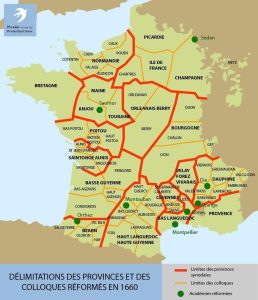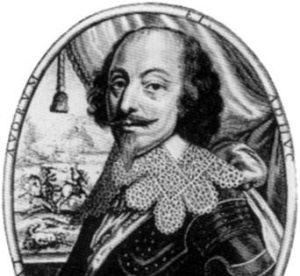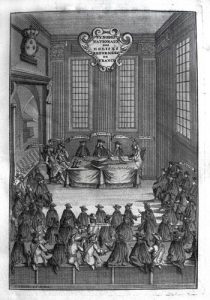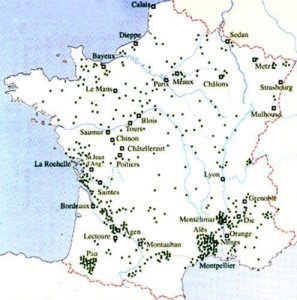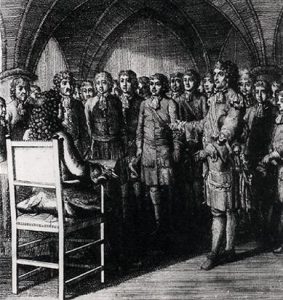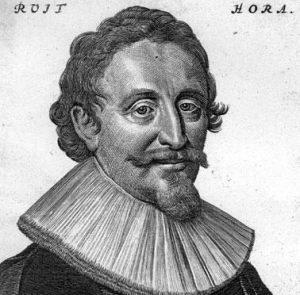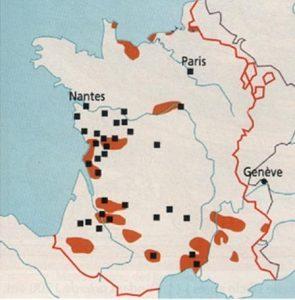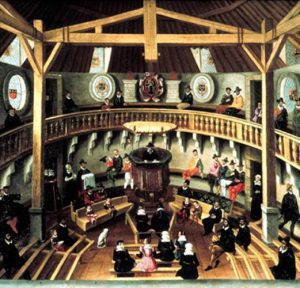A framework of several provinces
Since 1620, when the Béarn region lost its independence, the Reformed Churches of the French kingdom had been organised into a framework of 16 provinces.
Based on the frontiers of 1620, each province was listed with its number of churches and the estimated number of its Reformed population around 1660. The only exceptions were Sedan, Metz, Alsace and the region Montbéliard.
The Northern provinces
The six northern provinces had only a small Reformed population ; 135 000 members and 171 Churches ; half this population lived in urban areas.
- Ile-de-France, Picardy, Champagne, Metz
This large province had a Reformed population of only 51 000 and 47 Churches. The largest communities were in Paris (12 000), Meaux, Nanteuil (3 000), Calais, Alberville, Saint Quentin.
- Normandy
This province had Reformed population of 42 000 people and 43 Churches – the most important being Dieppe, Le Havre, Rouen, Caen, Bolbec. There were also many feudal Churches under the jurisdiction of the local landowner.
- Brittany
This province only had a Reformed population of 3 500 members and 11 Churches, including Nantes, Rennes and Vitré, as well as some feudal Churches.
- Anjou, Maine, Touraine
This province had a Reformed population of 10 200 and 21 Churches, including Tours, Saumur and Loudun. There were also some feudal places of worship.
- Orléanais, Berry
This province had a Reformed population of 11 500 and 23 Churches, including Blois, Mer, Chatillon, La Charité, Henrichemont.
- Burgundy
This province had a Reformed population of 17 000 and 26 Churches, including the ones in Lyon and some isolated groups in Auvergne and in the vicinity of Châlon and Dijon. In the Gex region, near Geneva, there were some large communities.
The Atlantic provinces
The Reformed population of the four Atlantic provinces was mostly rural : 293 000 and 227 Churches.
- Poitou
This province had a large Protestant population : 77 500 and 49 Churches, including Niort (the largest), Poitiers, Châtellerault and Thouars. In the eastern part of Vendée and the southern part of the Deux-Sèvres there were many feudal Churches.
- Saintonge, Aunis, Angounais
This province had a Protestant population of 93 500 and 60 Churches, including La Rochelle, Cognac and many Churches in small country towns.
- Basse-Guyenne
This province had the most important Protestant population : 97 000 and 72 Churches, including Bordeaux, Sainte Foy, Bergerac, Clairac, Nérac and also in the vicinity of these towns.
- Béarn
This small province, (whose Protestant population greatly declined in numbers when Béarn became part of the kingdom of France), still had 25 000 members in 46 Churches, including Nay-Pontacq, Pau, the Osse and Oloron valleys, Salies and especially Orthez.
Provinces of the South of France
Almost half the number of protestants in the entire kingdom lived in the six provinces of the South of France : 369 000 members in 298 Churches.
- Haut-Languedoc, Haute-Guyenne
This province had a Reformed population of 80 000 and 64 Churches, including Montauban, Millau, Castres and the vicinity, Foix, Mazamet and Revel.
- Bas-Languedoc
This province had a Reformed population of 81 000 and 63 Churches, including Montpellier and Nîmes (1 200 protestants). Vaunage, Vistrenge and Uzège were areas where the Protestants were a majority.
- Cévennes
This province had a Protestant population of 74 000 and 59 Churches, including Alès, Sauve and the upper part of the Tarn valley.
- Vivarais
This province had a Reformed population of 48 000 and 29 Churches, including Annonay. These mostly rural protestant communities could be found in large numbers in the Eyrieux valley, on the plains of Velay and in the Boutières region.
- Provence
This province had a mostly rural Protestant population of 80 000 and 12 Churches, including Manosque, Riez, Eyguières and le Luc. A group of Waldenses lived in the Durance valley (Mérindol, Lourmarin, Cabrières). There were few Protestants in Marseilles.
- Dauphiné
This province had a Reformed population of 78 000 and 71 Churches, including the Church of the principality of Orange, Montélimar, Dieulefit and Grenoble. Protestant communities existed in the lower Drôme valley, the Diois, the Drac valley and the Waldensian region between France and Italy.

